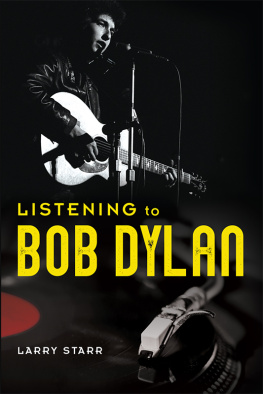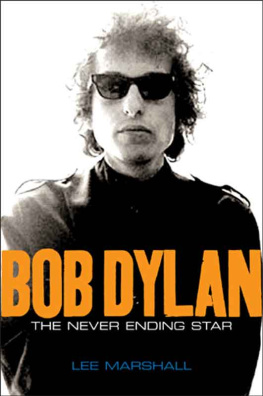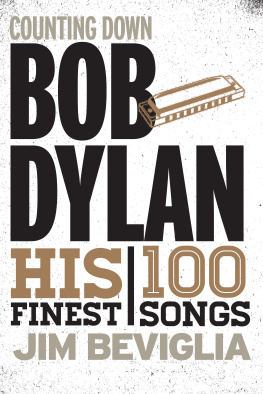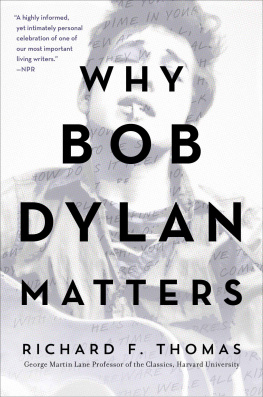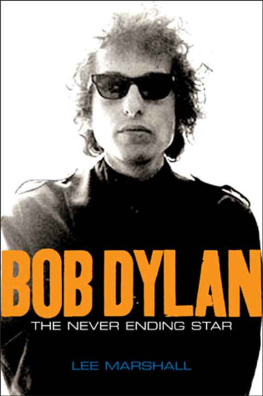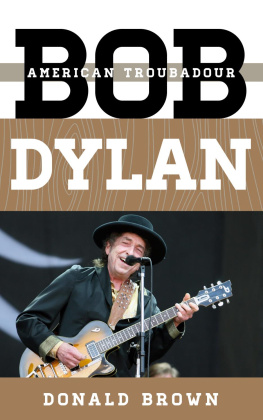NOT BY WORDS ALONE
Bob Dylan won a Nobel Prize in 2016for literature. This is now common knowledge. Still, it must be asked: Would anyone on the Nobel Prize jury even have heard of Bob Dylan were it not for his achievements as a performing songwriter?
Dylan himself articulated this paradox directly when he concluded his own Nobel lecture by observing that songs are unlike literature. Theyre meant to be sung, not read. And I hope some of you get the chance to listen to [my] lyrics the way they were intended to be heard: in concert or on record or however people are listening to songs these days. There is an ironic poignancy in these words, as the world-famous winner of one of the worlds ultimate prizes humbly pleads with us at last just to listen to his work. This book will take Bob Dylan at his word: that is to say, not by words alone.
Consider the question How does it feel? By itself its an everyday, unremarkable expression: one friend asking about anothers emotional well-being; a salesperson hoping that the new shoes are fitting properly; a doctor or dentist assessing a patients condition. Now imagine these same words being sung at you intensely by another person: How does it feeeeel? This is no longer that everyday question. Shaped by a familiar melody, rhythm, and vocal color, this can be one thing only, an evocation of Bob Dylan performing his iconic Like a Rolling Stone.
That little exercise demonstrates something more than Bob Dylans enormous impact on contemporary culture. It reveals the extent to which the very identity of Dylans work is defined by music and musical performance. The words How does it feel? become Like a Rolling Stone only when Dylans characteristic melody, rhythm, and vocal style are synthesized with them, becoming parts of an inseparable whole. The present book seeks to restore music and musical performance to their rightful positions, as central, essential aspects of Bob Dylans art.
Long before he was awarded the Nobel Prize, the widespread tendency was to regard Bob Dylan primarily or even exclusively as a poet, or as a writer of lyrics. But Dylans lyrics in isolation cannot properly represent his achievements or his work. How does it feel? provides a concise illustration. For a more substantial example, we might look to the 2006 edition of The Oxford Book of American Poetry, in which Dylans arrival as a significant literary presence was certified with the appearance of his lyrics for Desolation Row. The venerable anthology presents Desolation Row as a ten-stanza poem. But the presentation perpetrates a major distortion. The many listeners who have heard Dylans own original recorded performance of Desolation Row on his celebrated album Highway 61 Revisited (1965) know it as a twelve-stanza song, two complete stanzas of which are played on Dylans harmonica. The two missing stanzas are not so much as acknowledged in The Oxford Book of American Poetry. But does it make any sense to ignore two major sections of a major work simply because those sections are performed without words?
Music, no less than lyrics, deserves pride of place in any thorough consideration of song, and Dylans art achieves its total impact only as a complete packageas a personal, unique synthesis of words, music, and performance. The mission of this book is to illuminate that complete package through the examination of readily available Dylan recordings.
It is necessary to rely on recordings, because the published Bob Dylan songbooks are as insufficient in their own way for this purpose as the anthologies of his lyrics. The songbooks simplify, sometimes drastically, the rhythmic and melodic freedom that characterizes Dylans vocal performances and may omit some of his most colorful chord choices. The published vocal line for Like a Rolling Stone that appears in the so-called Definitive Bob Dylan Songbook hardly represents the varied ways Dylan sings that pivotal phrase How does it feel? Nor does that same Songbook offer a hint of the expressive, unusual, and dissonant guitar chord that accompanies the beginning of each vocal stanza in Dylans original recorded performance of Girl from the North Country on the album The Freewheelin Bob Dylan (1963).
There is, unfortunately, no Nobel Prize for songwriting. Song is an essential aspect of culture worldwide, and a prize in that area would clarify that song is a genre different from literature or musical composition; it is an art form of its own, drawing on elements of both, but distinct from either. Yet were Bob Dylan to have won a hypothetical Nobel for songwriting, that in itself would also have been insufficient, because his art is that of a performing songwriter. This is something yet again, contributing a third indispensable element to a distinctive, remarkable amalgam.
Bob Dylan, Musician: Singer, Instrumentalist, Composer
Bob Dylan is a singularly versatile and expressive singer, a man of many voices. He can be a chanting folksinger (Masters of War) or a hectoring rock shouter (Like a Rolling Stone) or a country crooner (Lay, Lady, Lay), and this list is just for starters. His voice can shape-shift, chameleon-like, from one track to the next on a single album. Is the energetic, amused narrator who sings the story-song Lily, Rosemary and the Jack of Hearts on the album Blood on the Tracks (1975) really the same person as the pain-struck, mournful vocalist on the immediately following track, If You See Her, Say Hello? And these two songs were recorded on the same day.
Dylan has employed his harmonica as yet another, alternative, singing voice throughout his long career. As an instrumentalist, he has also elected to use both acoustic and electric guitar in multiple ways. Sometimes he chose the piano rather than the guitar for certain songs, a choice that decisively influenced the expressive character of those selections; an essential contribution to the unusual dark mood created by Ballad of a Thin Man from the album Highway 61 Revisited is surely Dylans hard-edged piano playing. Bob Dylans song lyrics are vividly enhanced, colored, and even tweaked by his musical settings and performances, and vice versa, resulting in complex yet unified examples of songwriters art.
Why is it then that we so often encounter claims that Bob Dylan has a bad voice, that he cant really play his instruments, or that his music by itself is boring? It is important to debunk the assumptions underlying such statements.
Admittedly, Bob Dylan does not possess what is typically called a beautiful voice. But there is a crucial difference between having a beautiful voice and being a distinguished singing musician. To assume that an attractive vocal instrument automatically produces beautiful music makes about as much sense as to assume that playing an exquisitely fashioned violin, or guitar, automatically renders the performer a fine musician. Conversely, generations of rural musicians have coaxed wonderful music from well-worn fiddles and banjos. If someone has beautiful hands, would we suppose her automatically to be a skilled craftsperson? It is important not to confuse a surface attractiveness with artistic beauty. Artistic beauty is a much deeper, more complex quality.
A very gifted young student of opera pleasantly surprised and educated me when she proclaimed Bob Dylan a great singer and offered in explanation, Its not the instrument you have, its what you do with your instrument. I can see no way to improve on that formulation.
Many of the most remarkable and influential singers of twentieth-century popular music did not possess inherently beautiful voices. Perhaps the obvious and outstanding example is Louis Armstrong, a great singing musician who was capable of playing his voice with the same expressiveness and imagination with which he played his trumpet. Billie Holiday had an idiosyncratic vocal instrument with a limited range, but she employed it to create performances of enduring poignancy. And the singer whom every creator of the Great American SongbookIrving Berlin, George Gershwin, Cole Porter, and othersmost wanted to perform his songs? That was Fred Astaire, a man with a small, not obviously distinguished voice, who could also draw from his dancing vocabulary a feeling for vocal rhythm and phrasing second to none.

